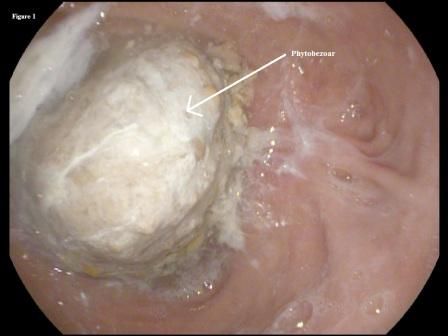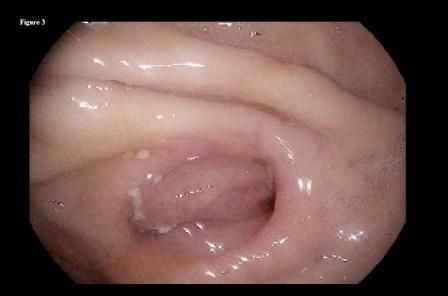Gastric Phytobezoar: A Case Report
Figure 1.

Figure 2.

Figure 3.

Figure 4.

A 59-year-old woman with a history of peptic ulcer disease (PUD) was seen in a clinic with complaints of pain in the epigastrium of several days’ duration. She described the pain as mild, burning, and nonradiating and noted that it worsened with food intake. She had nausea and reported occasional episodes of postprandial vomiting. The symptoms had not worsened significantly in the past few days.
She also complained of a sensation of abdominal bloating and some subjective weight loss. She denied any fever, constipation, or diarrhea. She did not report any hematemesis or melena. Her past medical history included a Billroth II procedure with Roux-en-Y revision for an anastomotic bleed, hypertension, type 2 diabetes mellitus, chronic obstructive pulmonary disease, and stroke with residual right-sided paraesthesias. Review of other systems was unrevealing. She was currently taking lisinopril, metformin, glipizide, clopidogrel, omeprazole, and albuterol pump. She did not have any known drug allergies. She had been smoking cigarettes for more than 20 years and admitted to occasional alcohol consumption. She also admitted to using cocaine intermittently. There was no family history of GI malignancies.
On physical examination, there was mild tenderness in the epigastric area on palpation. There was no guarding or rigidity. There was no abdominal mass palpated. A succussion splash was auscultated over the upper abdomen. (The “splash,” which is heard when the stethoscope is placed over the upper abdomen and the patient is rocked back and forth at the hips, suggests retained gastric contents.) However, the succussion splash was heard soon after a meal and did not persist beyond 3 hours. Bowel sounds were heard. There was no lymphadenopathy. The balance of the physical examination was notable only for mild pallor.
Laboratory tests revealed the following: hemoglobin 11 g/dL (12-16 g/dL); hematocrit 34% (37%-47%); MCV 82 fL (80.4-95.9 fL); MCH 26 pg/cell (27-31 pg/cell); MCHC 30.2 g/dL (32-36 g/dL); and RDW 14.6% (12%-15%). There were no electrolyte abnormalities, including hypokalemia and a hypochloremic metabolic alkalosis. Abdomen and pelvis CT with contrast revealed that the patient was status post partial gastrectomy. It also showed chronic stable intrahepatic and extrahepatic biliary ductal dilatation and pancreatic duct dilatation with pancreatic atrophy. Upper endoscopy was performed in view of the patient’s history of refractory PUD and multiple abdominal surgeries. It showed a normal gastric remnant, an ulcer at the anastomotic site, and a large bezoar on the gastric side of anastomosis (Figures 1 and 2). Biopsy from the mass showed vegetable fibers, confirming the diagnosis of phytobezoar.
A number of factors were considered before electing first-line treatment. The patient’s symptoms were mild and she had no clinical signs and symptoms of gastric outlet obstruction (GOO). She did not have persistent epigastric pain, repeated postprandial vomiting, abdominal distention, signs of volume depletion, or weight loss. The symptoms also were not getting progressively worse. She had no complications in the form of GI perforation, peritonitis, intussusception, pancreatitis, obstructive jaundice, upper GI bleeding, or pneumatosis intestinalis. On the basis of these parameters, the decision was made to treat her conservatively with chemical dissolution. There was no indication for an endoscopic procedure.
She was advised to continue with omeprazole and to drink one 12-oz can of Coca-Cola twice a day. She was also instructed to consume a diet of blended liquids (thickened soups for vegetables rather than raw vegetables) and take a soft mechanical diet. This diet was recommended for the foreseeable future because her prior surgery put her at high risk for recurrence of the phytobezoar.
She followed this regimen for the following 3 months with significant improvement in her symptoms. A repeated upper endoscopy performed at 3 months after presentation showed complete dissolution of the phytobezoar, with a clear view of the distal end of the gastric remnant (Figure 3) and the jejunal side of the anastomosis (Figure 4).
Discussion
Bezoars are composed of undigested foreign material or nutrients and may be located anywhere in the GI tract, although they are most commonly found in the stomach. The incidence is low and has been reported as 0.4% in the general population.1
Bezoars are classified into 4 types based on their composition: phytobezoars formed by vegetable and fruit fiber; trichobezoars formed by hair; lactobezoars formed by milk curd; and those caused by medications, fungus, sand, tar, etc, as well as those caused by stones (lithobezoar).2 Phytobezoars are the most common type encountered; they are composed of indigestible cellulose, tannin, and lignin from ingested fruits and vegetables. The most common predisposing factor for bezoar formation is prior GI surgery.2 Of these surgeries, vagotomy with pyloroplasty shows the highest incidence of bezoar (from 65% to 80%), whereas incidence among patients who have undergone antrectomy is 20%.2 Other risk factors include poor mastication, gastric dysmotility, and a vegetarian diet.
Gastric dysmotility or gastroparesis has a wide range of causes that includes diabetes mellitus; post-viral syndrome; medications (eg, narcotics, tricyclic antidepressants, calcium channel blockers, alpha2-adrenergic agonists, phenothiazines, dopamine agonists, cyclosporine); prior gastric or thoracic surgery (eg, Billroth II gastrectomy, fundoplication, lung or heart transplant, bariatric surgery); neurologic disease (eg, multiple sclerosis, brainstem stroke, diabetic or amyloid neuropathy, primary dysautonomias); and connective-tissue disorders, such as scleroderma.
Diospyrobezoars, a distinct type of phytobezoar, may form after persimmon or pineapple ingestion. They have been reported from some Asian countries. Tanin and shibuol, especially found in the skin of unripe persimmons, react with hydrochloric acid in the stomach and form a coagulum, which is the basis of the bezoar that accumulates cellulose, hemicellulose, and protein. They are more difficult to treat owing to their hard consistency.
Most patients with bezoars remain asymptomatic. The onset of symptoms is usually insidious. They may present with abdominal pain, dyspepsia, nausea, postprandial vomiting, abdominal mass, early satiety, and weight loss. Even though bezoars can become quite large, they rarely present with GOO. If severe unremitting abdominal pain with persistent postprandial vomiting develops, GOO should be suspected.
Complications associated with bezoars include intestinal obstruction, bleeding, and perforation. When untreated, they are associated with mortality rates of up to 30%.3 Small-bowel obstruction may be caused by intestinal migration of a gastric phytobezoar or by an in vivo intestinal bezoar. Rarely, bezoars may extend through the pylorus into the small intestine forming a tail. This is known as Rapunzel syndrome.4 GI endoscopy plays an important role, since it may be both diagnostic and therapeutic. Other imaging modalities that can be useful include abdominal ultrasonography and CT, and abdominal radiography with or without barium.
Treatment
Treatment options include chemical dissolution methods and endoscopic procedures. Agents used for chemical dissolution include cellulase, acetylcysteine, papain, pancreatic enzymes, saline solution, sodium bicarbonate, and carbohydrate beverages such as Coca-Cola, delivered either orally, endoscopically, or by gastric lavage. Ladas et al,5 first reported the efficacy of Coca-Cola in dissolving gastric phytobezoars in 2002. Coca-Cola lavage is an inexpensive, safe, effective, and easy to perform option and can be undertaken by any endoscopy unit. Diet Coke or Coke Zero, which both contain the artificial sweetener aspartame, can be used for diabetic patients and for persons who want to restrict their caloric intake. Diet Coke and Coke Zero have been reported to be equally as effective as the original kind because all other active ingredients remain the same. These agents may be used alone or in combination with endoscopic fragmentation. The actual mechanism by which Coca-Cola acts has not been elucidated but it is thought that it resembles gastric acid in terms of its pH of 2.6 (due to carbonic and phosphoric acid); this acidity is important for digestion of fibers. In addition, NaHCO3 has a mucolytic effect and CO2 bubbles enhance the dissolving mechanism.6 Coca-Cola helps diminish the size of the bezoar and soften its consistency, thus facilitating its removal by other subsequent modalities.
Endoscopic fragmentation, although effective as a first-line treatment, is cumbersome and expensive. It may be associated with small-bowel obstruction due to distal migration of the phytobezoar segments for up to 6 weeks following the procedure. Coca-Cola or other types of chemical agents should be used as initial therapy for patients with mild symptoms; endoscopic fragmentation is usually used when the initial therapy with chemical agents fails or in case of complications, such as GOO. A variety of endoscopic methods can be used, including mechanical or electrohydraulic lithotripsy, dormia basket, polypectomy snare, biopsy forceps, laser destruction, electrosurgical knife, and endoscopic removal with a large-channel endoscopy. After successful dissolution or removal of the phytobezoar, patients should be instructed to avoid a high-fiber diet. Many patients can be successfully treated using an endoscopic procedure and conservative management.
Ladas et al did a systematic review of the effectiveness of Coca-Cola for gastric phytobezoar dissolution. They identified 24 papers published between 2002 and 2012 that included 46 patients.6 They concluded that in 91.3% of the cases, phytobezoar dissolution with Coca-Cola administration was successful either as a single treatment (50%) or combined with further endoscopic techniques. Approximately 47% of patients had successful outcomes with drinking Coca-Cola alone; 34.8% with Coca-Cola lavage; and 17.4 % with a combination of drinking, injection, and lavage. Only 4 patients in their review underwent surgery. Also they found that although diospyrobezoars are more difficult to treat, Coca-Cola helps to soften their consistency and to decrease their size, making them amenable to additional endoscopic treatment. The initial size of the bezoar does not seem to influence the outcome, with studies showing no difference between bezoars occupying less than 50% or more than 50% of the gastric lumen. At the present time, it is not known whether continuous oral intake of Coca-Cola can prevent relapses after the initial response.6
In conclusion, this case highlights the importance of recognizing phytobezoars as a cause for the patient’s GI symptoms, since most of them can be effectively treated with Coca-Cola administration and fewer than 10% patients will require surgery. In half, complete dissolution is achieved with Coca-Cola alone (either with drinking, lavage, or intra-bezoar injection) and in the rest with only partial dissolution, subsequent endoscopic fragmentation can be performed with success.
References:
- McKechnie JC. Gastroscopic removal of a phytobezoar. Gastroenterology. 1972;62:1047–1051.
- Feldman M, Friedman L, Sleisenger MH, Fordtran JS. Sleisenger & Fordtran's Gastrointestinal and Liver Disease. 7th ed. London: WB Saunders; 2002:395–398.
- Singh SK, Marupaka SK. Duodenal date seed bezoar: a very unusual cause of partial gastric outlet obstruction. Australas Radiol. 2007;51 Spec No:B126–B129.
- Yang JE, Ahn JY, Kim GA, et al. A large-sized phytobezoar located on the rare site of the gastrointestinal tract. Clin Endosc. 2013;46:399-402. doi:10.5946/ce.2013.46.4.399. Epub 2013 Jul 31.
- Ladas S, Triantafyllou K, Tzathas C, et al. Gastric phytobezoars may be treated by nasogastric Coca-Cola lavage. Eur J Gastroenterol Hepatol. 2002;14:801-803.
- Ladas SD, Kamberoglou D, Karamanolis G, et al. Systematic review: Coca-Cola can effectively dissolve gastric phytobezoars as a first-line treatment. Aliment Pharmacol Ther. 2013;37:169-173. doi:10.1111/apt.12141.